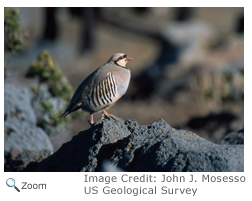Habitat

The chukar lives on rocky, arid hillsides and mountain slopes and canyon walls. It is also found in open and flat desert areas with little vegetation and on barren plateaus. It is an altitudinal migrator and will move from higher elevations to lower elevations during snowy weather.
Diet
 The chukar feed on seeds, grasses, bulbs, stems, fruit and leaves. It also eats small amounts of insects like grasshoppers, caterpillars, crickets and ants.
The chukar feed on seeds, grasses, bulbs, stems, fruit and leaves. It also eats small amounts of insects like grasshoppers, caterpillars, crickets and ants.
Life Cycle
Male and female chukars form pairs from February through April. The male will perform a courtship ritual that involves head-tilting and showing his barred flanks. Both the male and female will call out to each other and peck at objects on the ground.

The female lays 8-15 eggs in a scrape lined with grass, leaves and feathers within the shelter of rocks or brush. The male will often leave the female after she has laid her eggs. The chicks hatch after about 24 days and will leave the nest and start feeding on insects shortly after hatching. They will begin to fly when they are about two weeks old.
Behavior
The chukar rarely flies. It is a good runner and can also hop across the rocky terrain in its habitat. Except for during breeding season, chukars live in coveys of up to 40 birds.